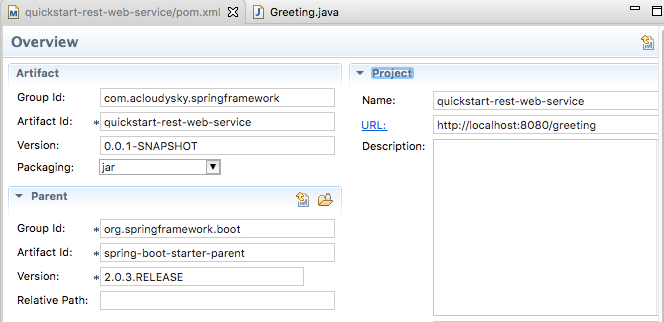quickstart-rest-web-service
This project shows how to create a RESTful Web Service. You can download the exanmples source code at sprinf-guides/gs-rest-service.
Overview
The Web service accepts GET requests at:
http://localhost:8080/greeting
It responds with a JSON representation of a greeting:
{"id":1,"content":"Hello, World!"}
You can customize the greeting with an optional name parameter in the query string:
http://localhost:8080/greeting?name=UserName
The name parameter value overrides the default value of "World" and is reflected in the response:
{"id":1,"content":"Hello, UserName!"}
Prerequisites
Steps
-
Actiivate Eclipse IDE.
-
From the menu bar select File->New->Other-Maven Project.
-
To the initial add the information shown next:
<project xmlns="http://maven.apache.org/POM/4.0.0" xmlns:xsi="http://www.w3.org/2001/XMLSchema-instance" xsi:schemaLocation="http://maven.apache.org/POM/4.0.0 http://maven.apache.org/xsd/maven-4.0.0.xsd"> <modelVersion>4.0.0</modelVersion> <groupId>com.acloudysky.springframework</groupId> <artifactId>quickstart-rest-web-service</artifactId> <version>0.0.1-SNAPSHOT</version> <packaging>jar</packaging> <name>quickstart-rest-web-service</name> <url>http://localhost:8080/greeting</url> <parent> <groupId>org.springframework.boot</groupId> <artifactId>spring-boot-starter-parent</artifactId> <version>2.0.3.RELEASE</version> </parent> <dependencies> <dependency> <groupId>org.springframework.boot</groupId> <artifactId>spring-boot-starter-web</artifactId> </dependency> <dependency> <groupId>org.springframework.boot</groupId> <artifactId>spring-boot-starter-test</artifactId> <scope>test</scope> </dependency> <dependency> <groupId>com.jayway.jsonpath</groupId> <artifactId>json-path</artifactId> <scope>test</scope> </dependency> </dependencies> <properties> <project.build.sourceEncoding>UTF-8 </project.build.sourceEncoding> </properties> <build> <plugins> <plugin> <groupId>org.springframework.boot</groupId> <artifactId>spring-boot-maven-plugin</artifactId> </plugin> </plugins> </build> <repositories> <repository> <id>spring-releases</id> <url>https://repo.spring.io/libs-release</url> </repository> </repositories> <pluginRepositories> <pluginRepository> <id>spring-releases</id> <url>https://repo.spring.io/libs-release</url> </pluginRepository> </pluginRepositories> </project>After the project setup; let's now build the actual web service.
-
Resource Representation Class. Let's remember that the service must handle a GET request for /greetings, with an optional name parameter in the query string. The request must return a 200 OK response in JSON format in the body, which represents a greeting. The response should look like this:
{ "id": 1, "content": "Hello, World!" }
Where: - id is a unique identifier for the greeting. - content is the greetign textual representation.
To model the greeting representation, you must create a resource representation class. Provide a plain old java object with fields, constructors, and accessors for the id and content data as shown next:
package com.acloudysky.springframework.quickstart_rest_web_service;
public class Greeting {
private final long id;
private final String content;
public Greeting(long id, String content) {
this.id = id;
this.content = content;
}
public long getId() {
return id;
}
public String getContent() {
return content;
}
}
- Resource Controller Class. In Spring’s when building RESTful web services, HTTP requests are handled by a controller. These components are easily identified by the @RestController annotation. You can see this in the GreetingController class below which handles GET requests for /greeting by returning a new instance of the Greeting resource class.
package com.acloudysky.springframework.quickstart_rest_web_service;
import java.util.concurrent.atomic.AtomicLong;
import org.springframework.web.bind.annotation.RequestMapping;
import org.springframework.web.bind.annotation.RequestParam;
import org.springframework.web.bind.annotation.RestController;
@RestController
public class GreetingController {
private static final String template = "Hello, %s!";
private final AtomicLong counter = new AtomicLong();
@RequestMapping("/greeting")
public Greeting greeting(@RequestParam(value="name", defaultValue="World") String name) {
return new Greeting(counter.incrementAndGet(),
String.format(template, name));
}
}
Let's analyze the GreetingController class which is deceptively simple but it implements very important Spring's concepts.
- The class uses Spring 4’s new @RestController annotation, which marks the class as a controller allowing every method to return a domain object instead of a view. It’s shorthand for @Controller and @ResponseBody rolled together. In this example, it returns a resource representation class Greeting obiect.
- The @RequestMapping annotation ensures that HTTP requests to /greeting are mapped to the greeting() method.
- The @RequestParam annotation binds the value of the query string parameter name into the name parameter of the greeting() method. If the name parameter is absent in the request, the defaultValue of "World" is used.
- Finally, the implementation of the method body creates and returns a new Greeting object with id and content attributes based on the next value from the counter, and formats the given name by using the greeting template.
##References

